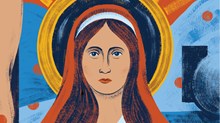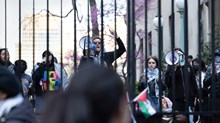[The Gnostics] wander from the truth, because their doctrine departs from Him who is truly God, being ignorant that His only-begotten Word, who is always present with the human race, united to and mingled with His own creation, according to the Father's pleasure, and who became flesh, is Himself Jesus Christ our Lord, who did also suffer for us, and rose again on our behalf, and who will come again in the glory of His Father, to raise up all flesh, and for the manifestation of salvation, and to apply the rule of just judgment to all who were made by Him. —Irenaeus, Against Heresies
In the year 177, Pothinus, the 90-year-old bishop of Lyons (in modern France), died after Romans beat him for two days. Pothinus' crime: insisting that Christ was the Christian God. Terrible persecution had come upon the Christians of Lyons and the neighboring city of Vienne, some 16 miles south on the east bank of the Rhone River. Christians were burned alive in the amphitheater. The young servant girl Blandina, after many tortures, was finally gored to death by a bull. Each martyr sacrificed himself or herself in imitation of the passion of Christ, their Incarnate God, in the hope of resurrection. So fundamental and pervasive was their resurrection-faith that the Romans cremated the martyrs' corpses and dispersed the ashes in the river to defeat any notion that the Christians would be raised bodily from their graves.
Pothinus's successor was named Irenaeus, meaning "man of peace," and the early Christian historian Eusebius honored Irenaeus as a peacemaker in keeping with his name. But this irenic pastor and diplomat was also the second-century church's most informed, prolific, and theologically profound opponent of Gnosticism.
Earlier Christian leaders such as Ignatius of Antioch and Justin Martyr had argued against false teachings that resembled Gnosticism, but Irenaeus was unique in his careful study of Gnostic myths (especially those taught by Valentinus) and in his immense, tireless reply.
Apostolic pedigree
Irenaeus was born sometime between 130 and 140 in Smyrna—today the city of Izmir in Turkey. As one strolls through the ruins of the ancient marketplace with its impressive colonnades, it is not hard to imagine the boy Irenaeus skipping by the altar of Zeus or observing Polycarp, the bishop of Smyrna, in theological discussion with the future Roman presbyter, Florinus, who later embraced the Gnostic ideas of Valentinus. In his youth, Irenaeus learned the key components of the Christian faith under Polycarp, who had been taught by the apostle John and others who had seen Christ.
Martyrdom was never far from Irenaeus. Polycarp was killed in February of 155/56. An account left by the church of Smyrna, The Martyrdom of Polycarp, provides a window into the faithfulness of an old man who saw himself as sharing in the sufferings of Christ and hoped for the resurrection of the body.
Irenaeus moved from Smyrna to Lyons (then called Lugdunum) and became a presbyter there. He was a trusted emissary of peace and on at least two occasions represented the church in doctrinal and liturgical controversies. The great persecution of Christians in Lyons occurred during one of his diplomatic missions to Rome, and so, when he returned, he became bishop in Pothinus' place.
Irenaeus wrote a number of books in his pastoral role, including Proof of the Apostolic Preaching, a short presentation of Christian faith. But his greatest literary work was the five-volume Against Heresies, written around 180 in response to the Gnostics and also the heretic Marcion. It is still valued today, not only because it is an early example of Christian biblical interpretation and theology, but also because it gives a careful account of a variety of Gnostic beliefs. Irenaeus broke new ground by consulting the Gnostic teachers and reading their literature in order to understand their teachings. He occasionally exaggerated his descriptions for the sake of argument, but now that we have access to many Gnostic writings from the Nag Hammadi collection, we know that his representations of Gnosticism were generally quite accurate.
Wolves in sheep's clothing
With his heart for peace, Irenaeus opposed the Gnostics not out of desire for power but out of concern for their salvation. He wanted, he said, to "turn them back to the truth" and "to bring them to a saving knowledge of the one true God."
Furthermore, he was a pastor with a responsibility to care for his flock. His opponents were enticing members of his community away from apostolic faith with a message that sounded true but wasn't. He therefore saw the Gnostics as false teachers who had cleverly and artfully clothed an unorthodox theological system in a deceitful, seductive costume. "Error," he noted, "indeed, is never set forth in its naked deformity, lest, being thus exposed, it should at once be detected. But it is craftily decked out in an attractive dress, so as, by its outward form, to make it appear to the inexperienced … more true than the truth itself."
As he wrote these words, Irenaeus had in mind Jesus' warning in Matthew 7:15 about false prophets who come in sheep's clothing but are inwardly ravenous wolves. The Gnostics sounded, and frequently acted, just like orthodox Christians. They read the Bible, used the Bible, and cited the Bible. But the way they understood the Bible, the way they put its pieces together, differed dramatically from the perspectives of Irenaeus, Pothinus, Polycarp, and John.
Irenaeus believed there was an unbroken line of tradition from the apostles, to those they mentored, and eventually down to himself and other Christian leaders. The Gnostics interpreted the Scriptures according to their own tradition. "In doing so, however," Irenaeus warned, "they disregard the order and connection of the Scriptures and … dismember and destroy the truth." So while their biblical theology may at first appear to be the precious jewel of orthodoxy, it was actually an imitation in glass. Put together properly, Irenaeus said, the parts of Scripture were like a mosaic in which the gems or tiles form the portrait of a king. But the Gnostics rearranged the tiles into the form of a dog or fox.
As a pastor, then, Irenaeus wrote Against Heresies in order to describe the heresies that were threatening his congregation and to present the apostolic interpretation of the Scriptures. He revealed the cloaked deception for what it was and displayed the apostolic tradition as a saving reminder to the faithful.
God became flesh
The Gnostics who threatened Irenaeus's community tended to divide things into two realities—one good, the other bad. In response to such dualism, Irenaeus presented the unity of apostolic faith.
For example, Irenaeus' opponents divided "Christ" from "Jesus." Christ, they said, was a divine spirit-being from the heavenly realm (the Pleroma, or "fullness") who did not become really incarnate, so he could not really suffer. He was not truly human, but either only seemed to be human or temporarily inhabited a human named "Jesus."
But Irenaeus was too familiar with the constant threat of martyrdom to let such dualism deceive his flock. The real, bloody passion and death of Christ was a fundamental element of Christian faith. Martyrdom imitated it, and Christians confessed it in baptism and worship. Irenaeus responded with a strong biblical statement that Jesus Christ was one person, both divine and human, and that he really was crucified.
This is what gave comfort to those who were martyred: "[Christ] knew, therefore, both those who should suffer persecution, and he knew those who should have to be scourged and slain because of Him; and He did not speak of any other cross, but of the suffering which He should Himself undergo first, and His disciples afterward."
At the root of the Valentinian Gnostic myth known by Irenaeus was a division between two Gods: the supreme, transcendent Father revealed by Christ, and the arrogant Demiurge, the creator of the physical world, who was identified with the Old Testament God of the Jews. Therefore, the Gnostics divided reality into two opposing realms—the heavenly world of spiritual beings (named "Aeons") and the material world of trees, rocks, earth, flesh, and blood.
In contrast to this, Irenaeus declared: "But there is one only God … He is Father, He is God, He the founder, He the Maker, He the Creator, … He it is whom the law proclaims, whom the prophets preach, whom Christ reveals, whom the Apostles make known to us, and in whom the church believes." These words reveal another important theme for Irenaeus: the harmony between the Old Testament and the emerging New Testament, between the prophets and apostles. The Creator spoken of by Moses is the Father revealed in Christ. His redemptive plan has been the same throughout history.
The Valentinian Gnostics also taught that, since the material world was created by an imposter, an ignorant deity, it had no value and must perish. The human body, as part of the material world, could never be immortal. This is why Christ could not have been truly human and why, the Gnostics believed, there would be no bodily resurrection or redemption of the created order. Salvation was purely spiritual.
But according to Irenaeus, the "spiritual" person is made up of the "the union of [material] flesh and [the human] spirit, receiving the Spirit of God." God created the physical world, and so that world has value and will be redeemed and renewed someday. God created the human body, and the body will be raised again incorruptible and immortal.
Against the Valentinians, Irenaeus emphasized the supernatural, redemptive ministry of the Holy Spirit who renews both the body and the spirit. This ministry of the Holy Spirit strengthened the martyrs to bear witness unto death in hope of bodily resurrection. This promise was based on the reality of Christ's incarnation: "For if the flesh were not in a position to be saved, the Word of God would in no wise have become flesh."
The faith that saves
The Gnostics had an elitist understanding of salvation; they divided humanity into two categories, the "spiritual ones" who belong to the Father and the "material ones" who belong to the Demiurge. As the "spiritual ones," the Gnostic believed, they were destined for salvation because of the divine spark within them (unlike the rest of humanity, who are asleep and have no hope).
Not so for Irenaeus. All humans are fallen—dead in their sins—and in need of redemption. Salvation is not a matter of destiny but of faith. The eternal Son of God, who became human, reunited God with humanity. Those who believe in him have the life of the Holy Spirit in them—and only they can be called "spiritual": "as many as fear God and trust in His Son's advent, and who through faith do establish the Spirit of God in their hearts—such men as these shall be properly called both 'pure,' and 'spiritual,' and 'those living to God,' because they possess the Spirit of the Father, who purifies man, and raises him up to the life of God."
So we see in Irenaeus the great orthodox doctrines of unity: One God, who is the Father and Creator of all things, immaterial and material, and who orchestrates one harmonious history of revelation and redemption; one Savior, who is both divine spirit and human flesh, both Christ and Jesus; one human nature, which is both spiritual and fleshly; one salvation of both the spiritual and material realms, which is by faith.
These were the doctrines Irenaeus received from those who had passed the apostolic teaching down to him. This was the orthodoxy that protected his flock against the wolves of heresy and that gave Polycarp and the martyrs of Lyons and Vienne the faith to endure even to the end.
D. Jeffrey Bingham is chair and professor of theological studies at Dallas Theological Seminary.
Copyright © 2007 by the author or Christianity Today/Christian History & Biography magazine.
Click here for reprint information on Christian History & Biography.

Support Our Work
Subscribe to CT for less than $4.25/month





























